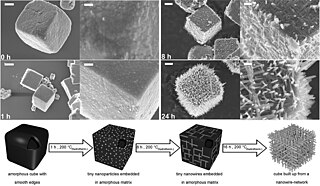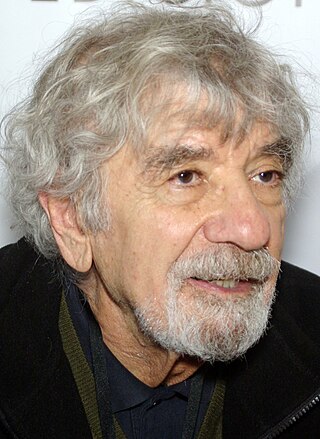Warren Sturgis McCulloch was an American neurophysiologist and cybernetician, known for his work on the foundation for certain brain theories and his contribution to the cybernetics movement. Along with Walter Pitts, McCulloch created computational models based on mathematical algorithms called threshold logic which split the inquiry into two distinct approaches, one approach focused on biological processes in the brain and the other focused on the application of neural networks to artificial intelligence.

Heinz von Foerster was an Austrian American scientist combining physics and philosophy, and widely attributed as the originator of Second-order cybernetics. He was twice a Guggenheim fellow and also was a fellow of the American Association for the Advancement of Science, 1980. He is well known for his 1960 Doomsday equation formula published in Science predicting future population growth.

Self-organization, also called spontaneous order in the social sciences, is a process where some form of overall order arises from local interactions between parts of an initially disordered system. The process can be spontaneous when sufficient energy is available, not needing control by any external agent. It is often triggered by seemingly random fluctuations, amplified by positive feedback. The resulting organization is wholly decentralized, distributed over all the components of the system. As such, the organization is typically robust and able to survive or self-repair substantial perturbation. Chaos theory discusses self-organization in terms of islands of predictability in a sea of chaotic unpredictability.
Gotthard Günther was a German (Prussian) philosopher.
Second-order cybernetics, also known as the cybernetics of cybernetics, is the recursive application of cybernetics to itself and the reflexive practice of cybernetics according to such a critique. It is cybernetics where "the role of the observer is appreciated and acknowledged rather than disguised, as had become traditional in western science". Second-order cybernetics was developed between the late 1960s and mid 1970s by Heinz von Foerster and others, with key inspiration coming from Margaret Mead. Foerster referred to it as "the control of control and the communication of communication" and differentiated first order cybernetics as "the cybernetics of observed systems" and second-order cybernetics as "the cybernetics of observing systems". It is closely allied to radical constructivism, which was developed around the same time by Ernst von Glasersfeld. While it is sometimes considered a break from the earlier concerns of cybernetics, there is much continuity with previous work and it can be thought of as a distinct tradition within cybernetics, with origins in issues evident during the Macy conferences in which cybernetics was initially developed. Its concerns include autonomy, epistemology, ethics, language, reflexivity, self-consistency, self-referentiality, and self-organizing capabilities of complex systems. It has been characterised as cybernetics where "circularity is taken seriously".

Andrew Gordon Speedie Pask was an English author, inventor, educational theorist, cybernetician and psychologist who made contributions to cybernetics, instructional psychology, experimental epistemology and educational technology. Pask first learned about cybernetics in the early 1950s when the originator of the subject, Norbert Wiener, spoke at Cambridge University, where Pask was an undergraduate student. Pask was asked to be of assistance during Wiener's talk.

Humberto Maturana Romesín was a Chilean biologist and philosopher. Many consider him a member of a group of second-order cybernetics theoreticians such as Heinz von Foerster, Gordon Pask, Herbert Brün and Ernst von Glasersfeld.

Albert Jakob Eschenmoser (born 5 August 1925) is a Swiss organic chemist, best known for his work on the synthesis of complex heterocyclic natural compounds, most notably vitamin B12. In addition to his significant contributions to the field of organic synthesis, Eschenmoser pioneered work in the Origins of Life (OoL) field with work on the synthetic pathways of artificial nucleic acids. Before retiring in 2009, Eschenmoser held tenured teaching positions at the ETH Zurich and The Skaggs Institute for Chemical Biology at The Scripps Research Institute in La Jolla, California as well as visiting professorships at the University of Chicago, Cambridge University, and Harvard.

Stuart Anspach Umpleby is an American cybernetician and professor in the Department of Management and Director of the Research Program in Social and Organizational Learning in the School of Business at the George Washington University.

The American Society for Cybernetics (ASC) is an American non-profit scholastic organization for the advancement of cybernetics as a science, a discipline, a meta-discipline and the promotion of cybernetics as basis for an interdisciplinary discourse. The society does this by developing and applying cybernetics’ concepts which are presented and published via its conferences and peer-reviewed publications. As a meta-discipline, it creates bridges between disciplines, philosophies, sciences, and arts. The ASC is a full member of the International Federation for Systems Research (IFSR).

Cybernetics is a wide-ranging field concerned with circular causal processes such as feedback. Norbert Wiener named the field after an example of circular causal feedback - that of steering a ship where the helmsman adjusts their steering in response to the effect it is observed as having, enabling a steady course to be maintained amongst disturbances such as cross-winds or the tide.
Henry Quastler was an Austrian physician and radiologist who became a pioneer in the field of information theory applied to biology after emigrating to America. His work with Sidney Dancoff led to the publication of what is now commonly called Dancoff's Law.
Karl H. Müller is an Austrian social scientist, and director of the Steinbeis Transfer Center New Cybernetics in Vienna. He is particularly known for his 2005 work with J. Rogers Hollingsworth on "Advancing Socio-Economics: An Institutionalist Perspective"
The Symposium on Principles of Self-Organization was held at Allerton House on 8–9 June 1960. It was a key conference in the development of cybernetics and was in many ways a continuation of the Macy Conferences. it was organised by Heinz von Foerster through the Biological Computer Laboratory based at University of Illinois at Urbana-Champaign. It was sponsored by the Information Systems Branch of the U.S. Office of Naval Research.
Alfred Inselberg was an American-Israeli mathematician and computer scientist based at Tel Aviv University.
Self-organization, a process where some form of overall order arises out of the local interactions between parts of an initially disordered system, was discovered in cybernetics by William Ross Ashby in 1947. It states that any deterministic dynamic system automatically evolves towards a state of equilibrium that can be described in terms of an attractor in a basin of surrounding states. Once there, the further evolution of the system is constrained to remain in the attractor. This constraint implies a form of mutual dependency or coordination between its constituent components or subsystems. In Ashby's terms, each subsystem has adapted to the environment formed by all other subsystems.
Jerome Elkind is an American electrical engineer and computer scientist. In 1988 he was co-founder of the Lexia Institute.
Lars Löfgren is a Swedish cybernetician. He was awarded the Wiener Gold Medal by the American Society for Cybernetics in 2008.